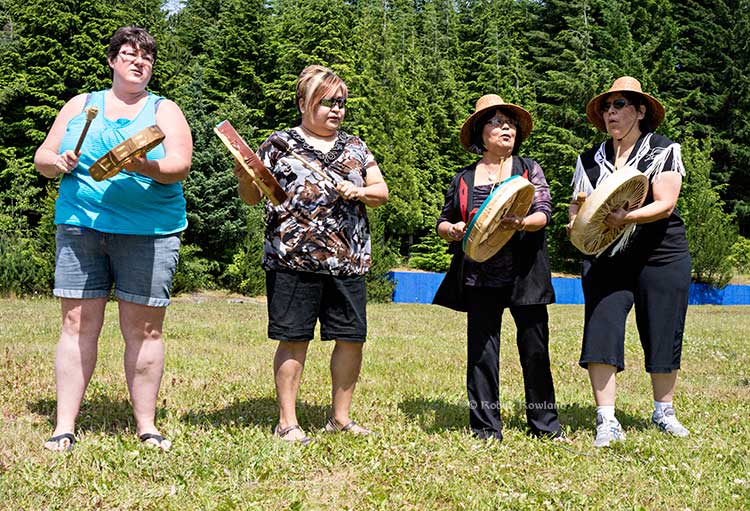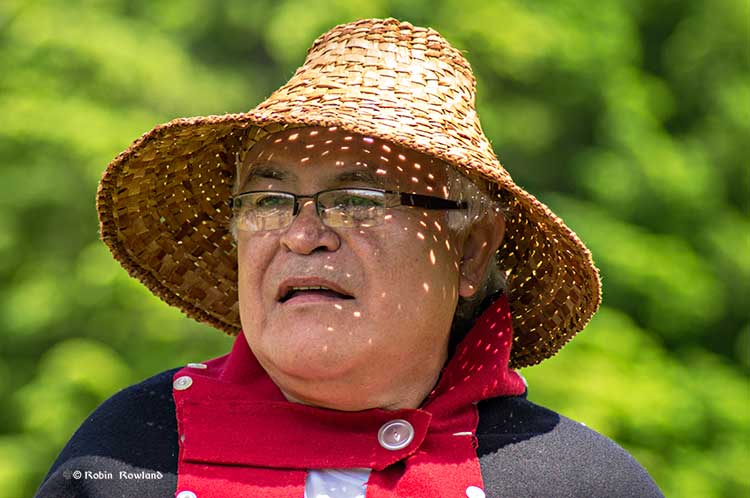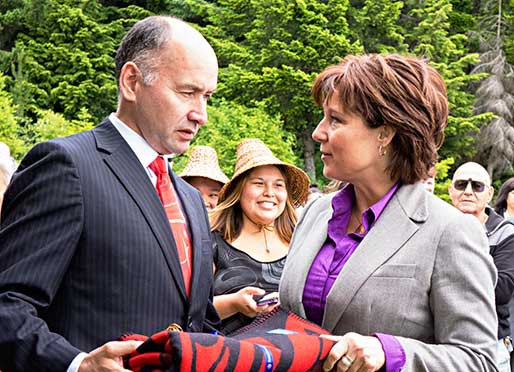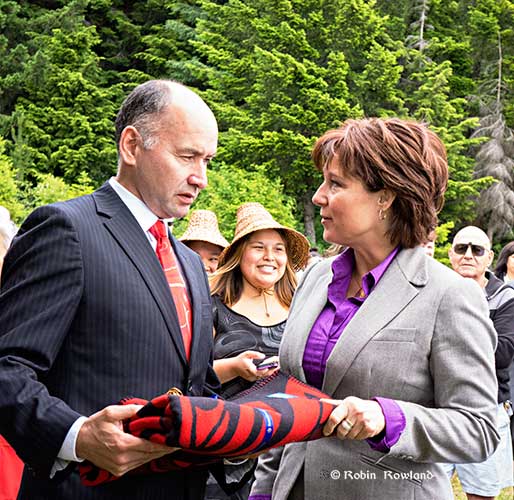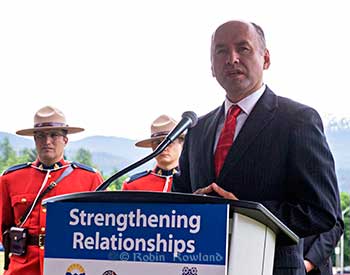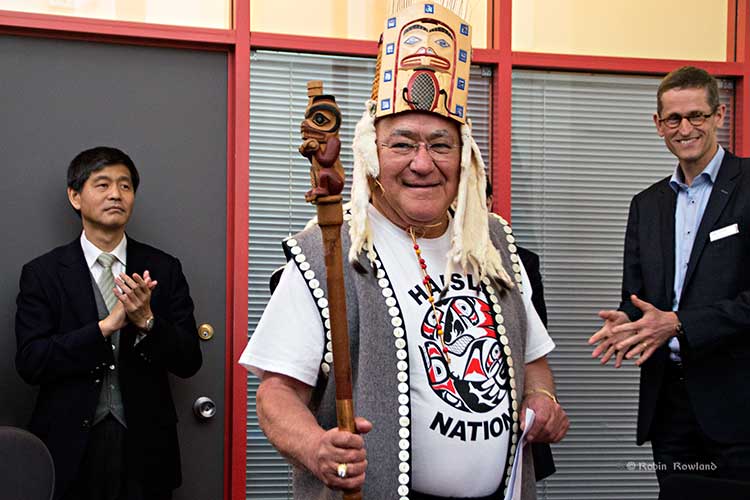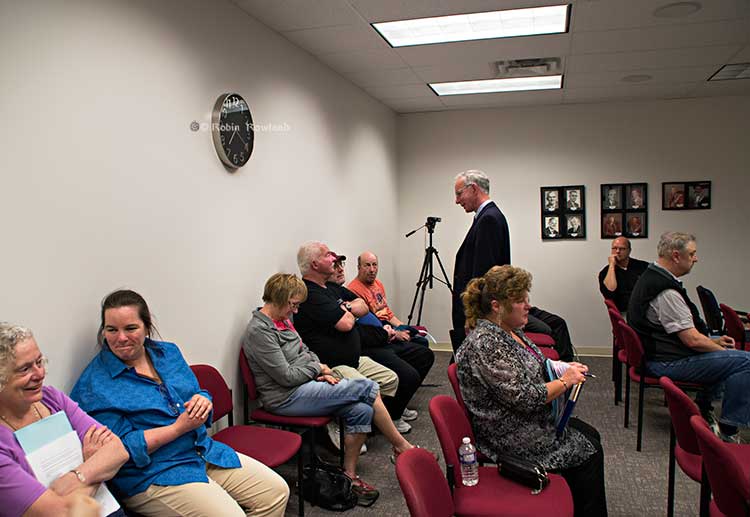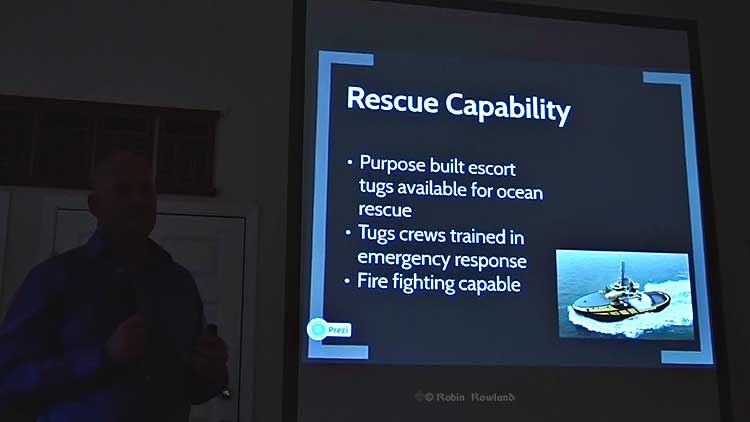The sudden release early Friday, July 18, by the British Columbia Ministry of the Environment about the Kitimat Valley air shed study brings more questions than the answers it provides; some questions are political, some technical.
The questions include
1. Why was the study suddenly released after the province said it was “privileged?”
2. Did the apparently rushed release mean that the study, as far as the public is concerned, is incomplete?
3. While most people in Kitimat believed that the study would be a wide ranging look at all parameters of industrial development in the valley, it was limited to just two factors, sulphur dioxide and nitrogen dioxide.
4. It appears that everyone involved were consulted prior to the release with one key execption, the District of Kitimat. Why?
5. The study appears to have changed in its criterion from the time of the request for proposal and the final release one issue—an oil export terminal, which went from “crude” in the request for proposal to refined in the final report.

While the study is spun has a showing that industrial development in the Kitimat Valley can proceed as long as the environment is properly managed, the gaps and the spin will likely bring doubt to the results. That means that a wider ranging and truly independent study of the air shed is needed so that both residents and industry can then make the proper decisions.
Ironically, a proper study may actually come from industry, rather than government since LNG Canada has said that a full air shed study will be part of its environmental assessment filing expected in the fall.
The air shed proposal
In October 2013, the Ministry of the Environment issues a “request for proposal” to “study potential cumulative effects to environment and human health from existing and proposed industrial facilities in the Kitimat airshed.” to be filed by March 31, 2014.
According to the government website,
The Province will fund a $650,000 scientific study to help inform regulatory and policy development for future industrial activity in the Kitimat area. The goal is to ensure the potential impacts from industrial air emissions are clearly understood prior to new projects being approved and in operation.
The Kitimat Airshed Impact Assessment Project will look at the cumulative effects of existing and proposed industrial air emissions in the airshed. These include emissions from: an existing aluminium smelter, three proposed LNG terminals, a proposed oil refinery, a crude-oil export facility, and gas-turbine-powered electrical generation facilities. The study will focus on sulphur dioxide and nitrogen dioxide emissions from these facilities.
The study will assess the impact of emissions through a number of scenarios, including their potential effects on water and soil, as well as on vegetation and human health from direct exposure.
With that news release, it appears that many people assumed that “cumulative effects of existing and proposed industrial air emissions in the air shed,” would include all possible scenarios and contaminants.
The report, when it was released on Friday, covered just the “focus” sulphur dioxide and nitrogen dioxide and no other factors in air quality.
Crude or refined oil export?
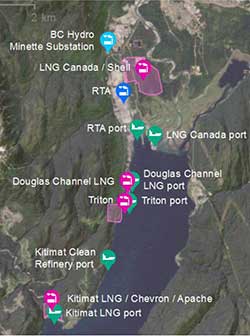 As Northwest Coast Energy News noted that the report, as released, doesn’t include any references to the Enbridge Northern Gateway project, even though Northern Gateway is a source of “proposed industrial air emissions in the air shed.” The request for proposal also mentions “a crude-oil export facility” but the report as issued concerns a marine terminal for Black’s refinery
As Northwest Coast Energy News noted that the report, as released, doesn’t include any references to the Enbridge Northern Gateway project, even though Northern Gateway is a source of “proposed industrial air emissions in the air shed.” The request for proposal also mentions “a crude-oil export facility” but the report as issued concerns a marine terminal for Black’s refinery
David Black’s Kitimat Clean website says
The products will be exported via a marine terminal on the Douglas Channel. Projected volumes include 320,000 barrels per day of diesel fuel, 110,000 barrels per day of gasoline and 60,000 barrels per day of jet fuel.
The map in the main report clearly shows that the study concerned the “Kitimat Clean Refinery Port” not a crude oil export facility—in other words likely Enbridge Northern Gateway.
Kitimat excluded
On October 21, 2013, District of Kitimat Council endorsed a motion by former Councillor Corinne Scott:
“The BC Government has recently announced a budget of $650,000 to study the cumulative effects on the air quality due to the proposed industrial development in the District of Kitimat. It would be beneficial to have a representative from the District of Kitimat as an active participant on the committee to provide input and feedback as the study progresses.”
At the time Chief Adminstrative Officer Ron Poole told council that the minister’s office had called and promised to “involve the District.”
At that meeting, Councillor Mary Murphy reported that member were “vocal” at the Union of BC Municpalities that it was essential that Kitimat be involved. Councillors suggested that the study be wide ranging and include emissions already in the area and residual emissions left over from the closed Eurocan and Methaex operations.
The provincial final air shed report makes no mention at all of the District of Kitimat, Eurocan or Methanex.
In April, 2014, after the March 31, reporting deadine, the District and Council had heard nothing from the province. So in April, District Council passed a motion asking for a report on the status of the study.
Crown Privilege
In June, the province refused to release the report to lawyers involved in a suit against the Environmental Assessment Board which is challenging Rio Tinto Alcans’ permit to increase sulphur dixoide emission in the valley. According to the Globe and Mail, Dennis Doyle, a lawyer with the Ministry of the Attorney General, in the RTA suit, wrote to the Environmental Law Centre in Victoria
In a follow-up letter dated June 12, Mr. Doyle said, “On the matter of the Kitimat Airshed Study I am instructed that this report was prepared to guide development of government policy on industrial development in the Kitimat area and to assist the executive council in its ongoing deliberations. It is not a report that was prepared for the Respondent and played no part of the decision-making process for the permit amendment which is now under appeal.”
In mid-July, the lawyers then asked the Environment Assessment Board to either turn over the air shed report or explain why it was covered by Crown Privilege.
The EAB told the province to respond to that question by July 18. Instead there was a hastily called news conference and the report was released. However, a close look at the report shows that it was likely rushed to meet the EAB deadine and was incomplete—rather surprising for a report that was supposed to be complete by March 31.
Rushed report
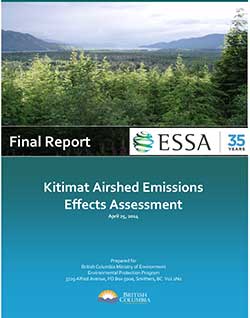 What evidence is there that the report was rushed out by the Ministry of the Environment? The most compelling indication is that instead of a public-friendly Summary Report with an executive summary and clear conclusions, there was nothing more than a short Power Point presentation.
What evidence is there that the report was rushed out by the Ministry of the Environment? The most compelling indication is that instead of a public-friendly Summary Report with an executive summary and clear conclusions, there was nothing more than a short Power Point presentation.
Most people in Kitimat who follow the energy debate are familiar with the approach of combining a readable summary with technical data. It is most evident in the report of the Enbridge Northern Gateway Joint Review, which issued a relative short summary, Connections along with the long technical report, Considerations.
Let’s take as a prime example, the original report on the Kitimat airshed commissioned by Rio Tinto Alcan. In that case, ESSA Technologies Ltd of Vancouver, the company hired by the RTA Kitimat Modernization Project to study the effects of increased sulphur dioxide emissions in the Kitimat Valley, issued three documents, an easy to understand 37-page summary report, a much longer 456 page Technical Assessment Report and a third 332 page volume of appendices, technical data and tables.
It was the same company, ESSA Technologies, that was retained by the province to do the much larger study of the airshed. However, the only public-friendly information was the 16 page highly simplified Power Point presentation.
The ESSA summary report for RTA shows in plain language, the reasons for its conclusions that the increased sulphur dioxide from KMP on human health “is characterized as moderate, an acceptable impact, but in need of closer scrutiny with moderate monitoring.” That report also outlines the limitations and uncertainties of the study.
There was no similar plain language summary released for the overall provincial air shed study, even though it was produced by the same company and came to similar conclusions. To find any limitations or uncertainties in the provincial air shed study you have to do a computer search for those key words.
So it is apparent that intended audience for the report is not really those who live in Kitimat, where over the past five years there is wide knowledge that a summary release along with a technical report is considered a standard procedure.
Kitimat not consulted
At the Friday news conference, reporters asked Environment Minister Mary Polak several times about the delay in releasing the report, and then why it was suddenly released.
In answer to the initial question, Polak said, “We had always intended to release it.” She refused to comment on the claim of cabinet privilege, saying that was the responsibility of government lawyers at the Ministry of the Attorney General. She said that the government had received the March 31 report “by the end of April and “it went through quite a rigorous and thorough review by different agencies… we are satisfied now that the findings have been given the kind of rigorous overview and we’re pleased with what has resulted from that.”
Polak said the Haisla Nation were consulted before the commissioning of the report.
Asked again about who the BC government consulted during the review period, she replied, “There were a number of other groups involved in technical review, so not just Ministry of Environment, you’ll be aware of Northern Health authority, but Ministry of Natural Gas Development, Health Canada, Environment Canada and also specialist reviewers from the Province of Quebec, the University of Helsinki, UBC, also private consultants. Then we spent some time going over and having a technical review with Gitga’at and Coastal Coastal First Nations. So it was a matter of ensuring that we had done the very best review of the work before the occasion on which we released it.”
Which leaves one big question, why was the Province of Quebec and the University of Helsinki consulted and Kitimat, despite requests, was not?
Not in the report, not my department
The provincial government called for a report on the “cumulative effects of existing and proposed industrial air emissions” and noted it would focus “ focus on sulphur dioxide and nitrogen dioxide emissions from these facilities.” It is clear that the report did not go beyond the narrow focus on those two substances.
At the Vancouver news conference, a reporter asked Polak why green house gases were not included.
She replied, “That’s not what this study was intended to look at. This department deals with pollutants and pollution and protecting our environment from it, whereas GHG [green house gas] emissions are dealt with in our department around climate change and climate action. These particular substances have an immediate impact on human health and vegetative health and the receiving environment generally unlike GHGs which are a more global impacted and of course have an impact on climate change. This study only looked at those pollutants sulphur doixide and nitrogen dioxide
Then a second reporter asked here about particulate matter, to which Polak replied, “Coming from the Fraser Valley I am very aware of the impact of particulate matter. Any industrial development that we permit in British Columbia or receives an environmental assessment certificate, particulate matter and the release of particulate matter is one of the things that gets evaluated as we determine whether or not to grant those permits. Or to put stipulations on those permits in order to ensure a reduction or management of particulate matter. That’s where that’s dealt with and we have some pretty good understanding of how that operates. We also have some modelling from this study.
“The reason this study didn’t report on that because we hadn’t asked them to. We specifically wanted to get at the issue of sulphur disoxide and nitrogen dioxide but please do not take frm that because it’s not in the study, it doesn’t get looked at. It simply gets looked at in a different process. In this case it was the understanding of the Kitimat air shed with respect to sulphur dixoide and nitrogen dioxide that we needed to have a better answers and better information.”
In other words, despite what the original proposal said: “The goal is to ensure the potential impacts from industrial air emissions are clearly understood prior to new projects being approved and in operation,” the provincial government is content to wait until the permit phase to consider particulate matter, rather than include particulate matter in the long term planning for the air shed.
And for green house gases, the same attitude seems to apply, either it’s not her department or it will be dealt with sometime in the future.
What’s going on in the air shed?
Although the provincial government has been able to spin that the air shed report clears the way for more industrial development in the region, the report isn’t much help for long term planning for those both for and against industrial development in the valley.
First one has to wonder just how comprehensive was the study, even when it comes to sulphur dioxide and nitrogen dioxide?
The report for Rio Tinto Alcan for just one substance—sulphur dixoide—from one industry—aluminum smelting–led to a 456 page technical report with 332 pages of appendices.
The provincial technical report adds one more substance, nitrogen dioxide, and adds four LNG facilities, an oil refinery, different export terminals for those industries, and two hydro generating stations plus related shipping, including a passing mention of vehicular and train traffic. The new report is 363 pages, including the appendices. (It should be noted that the air shed report does reference some of the information in the RTA report)
The various studies for the Enbridge Northern Gateway, which often contained material on air emissions, included a much longer list of what in industry jargon are called CPOC “chemicals of potential concern,” including chemicals that might be released in trace amounts from the Northern Gateway terminal, but may be of more concern from LNG projects. Who knows unless those substances are studied?
As was required by the Joint Review Panel, Enbridge also studied potential problems from accidental release of air-borne contaminants from the Northern Gateway project. There is no mention of accidental release in the current air shed study.
Although the increase in truck traffic in Kitimat is clearly visible to people who live in the town, the air shed report also speculates that with LNG and a possible refinery, there will also be a significant increase in rail traffic coming into Kitimat, hauled, of course, by diesel locomotives, which the report says is “expected to be conservatively captured within the background concentration adjustment.”
Can the Valley “handle industrial expansion”
Stakeholders in the region from the District of Kitimat to the Gitga’at First Nation to various environmental groups asked for a comprehensive review of what is going to happen in the Kitimat air shed with industrial expansion.
So the answer to the question can the valley “handle industrial expansion” after the flawed and limited report from the provincial government is not “yes,” but “we don’t know yet.”
It appears that the report is part of Christy Clark’s ongoing campaign that LNG will save the provincial economy.
There are two factors the report ignores.
First the energy companies are going to make their final investment decision on cold hard facts, including their own assessment of the potential problems from the air shed, not spin from the provincial government.
Second, until there is a proper air shed study, the First Nations, including the Haisla in Kitimat, the Gitga’at at Hartley Bay, the Kitselas in Terrace will not have solid evidence to make a decision on the details of the LNG or refinery development on their traditional territory and increased ship traffic along the coast and that will come into immediate conflict with the Supreme Court ruling on the Tsilhqot’in decision and the finding that “Whether a particular use is irreconcilable with the ability of succeeding generations to benefit from the land will be a matter to be determined when the issue arises.”
There is a new Orwellian phrase used by both the federal and provincial government. Every report is “independent” and “science-based,” although all they all tend to support the policy of the commissioning agency.
What the Kitimat Valley, Douglas Channel and the Terrace region need is a truly independent and truly science based and truly comprehensive evaluation of the air shed. At the moment, that doesn’t exist. It should whether it comes from industry or if the local governments can find the budget to fund a proper study or some combination of the two.
Links
Kitimat Airshed Assessment
RTA report Sulphur-dioxide-technical-assessment.html
(Scanned version of copy in Kitimat public library)
Related
Business in Vancouver
Kitimat airshed modelling has narrow focus
Vancouver Observer
Province’s air pollution study green lights LNG build-up, but ignores climate change
News release: Andrew Weaver MLA
New airshed study is a “nail in the coffin” for government LNG dreams in Kitimat


